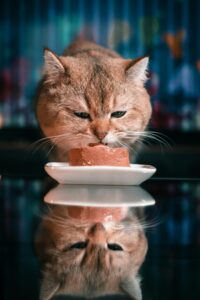Unlocking the Secrets of Cat Food Labels: A Detailed Guide for Responsible Pet Owners
Understanding how to read cat food labels is crucial for ensuring your cherished feline gets the nutritional balance essential for optimal health and longevity. These labels provide vital information that goes far beyond just the printed words on a package; they act as a comprehensive roadmap that reveals the quality and nutritional composition of your cat’s diet. By becoming familiar with these labels, you empower yourself to make informed and beneficial choices that positively influence your cat’s overall well-being and lifespan.
One of the core elements of cat food labels is the specific terminology that is employed. Terms like “complete and balanced” indicate that the product complies with the nutritional standards set by the Association of American Feed Control Officials (AAFCO). By understanding these terms, you can select foods that provide the essential nutrients your cat needs to flourish. This awareness empowers you to make informed dietary decisions that cater to your cat’s unique nutritional requirements, ensuring they lead a healthy and vibrant life.
When you scrutinize cat food packaging, you will come across terms such as ‘natural’ or ‘organic’. Although these labels may sound appealing to consumers, they carry different definitions and implications regarding quality. The term ‘natural’ typically suggests the absence of artificial flavors or colors, but it does not guarantee the overall quality of the food. In contrast, ‘organic’ signifies adherence to specific production methods that generally result in a higher standard of safety and quality, making it a preferred choice for discerning pet owners who prioritize their cat’s health.
The AAFCO plays a pivotal role in establishing nutritional guidelines within the pet food sector. Their standards ensure that products labeled as ‘complete and balanced’ meet specific nutritional criteria appropriate for various life stages. Understanding these labels is essential for pet owners who wish to make educated choices about their cat’s diet and health. By applying this knowledge, you can confidently select the most suitable options that cater to your feline’s individual needs.
Having a clear grasp of the information presented on your cat’s food label can dramatically enhance your ability to make nutritious choices that promote their health and well-being. The insights you gain will empower you to opt for high-quality food that aligns with your cat’s dietary needs, contributing significantly to their overall happiness and longevity.
 Essential Guide to Understanding Cat Food Ingredients: Key Insights for Pet Owners
Essential Guide to Understanding Cat Food Ingredients: Key Insights for Pet Owners
A crucial aspect of decoding cat food labels involves a meticulous examination of the ingredients list. Ingredients are usually listed in order of weight before cooking, meaning that the first few items on the list represent the food’s primary constituents. This hierarchy is significant, as it provides valuable insight into what your cat is consuming regularly and how it supports their health.
For cats, who are obligate carnivores, it’s imperative that high-quality protein sources take precedence on the ingredient list. Look for explicit protein sources such as chicken, beef, or salmon listed at the top, rather than vague terms like ‘meat meal’. This level of specificity indicates a superior quality and a more nutritious diet that aligns with your cat’s natural dietary requirements, ultimately supporting their health and vitality.
It is equally vital to identify and minimize certain additives and fillers in your cat’s diet. Ingredients such as corn, soy, or wheat gluten may enhance the food’s volume but offer minimal nutritional value for cats. Instead, prioritize options that incorporate whole grains and vegetables, as these can provide healthier alternatives and contribute to a well-rounded, nutritious diet that supports your cat’s health.
Be wary of artificial preservatives commonly found in pet foods, such as BHA, BHT, and ethoxyquin. Although these substances are frequently added to extend shelf life, they may not be the healthiest choice for your feline companion. Instead, opt for foods that utilize natural preservatives like vitamin E (tocopherols) or vitamin C (ascorbyl palmitate) to maintain the integrity and quality of their diet.
If you come across unfamiliar or overly complex ingredient names, take the time to research them. Being well-informed about what your cat consumes is the most effective way to ensure you are making choices that truly support their health and well-being, leading to a happier and healthier life.
Maximizing Your Cat’s Health: Analyzing Nutritional Content for Optimal Diet
Grasping the significance of the Guaranteed Analysis section on cat food labels is essential for understanding the nutrient profile of the food. This section generally outlines the minimum or maximum percentages of crude protein, fat, fiber, and moisture. Achieving the right balance among these nutrients is vital for maintaining your cat’s overall health and well-being.
Protein content is a paramount consideration when selecting cat food. Cats require substantial levels of protein to thrive, so it’s crucial to ensure that adequate amounts come from animal sources, which provide the essential amino acids necessary for their health. Avoid foods that rely heavily on plant-based proteins, as these often lack the full spectrum of nutrients that cats require for optimal health and energy levels.
Carbohydrate content is another important factor to consider in your cat’s diet. While some carbohydrates can be beneficial in moderation, they should not dominate the ingredient list, especially for cats that may be prone to weight gain or obesity. Aim for foods that emphasize higher protein and lower carbohydrate levels to promote a healthy, balanced diet that meets your cat’s specific needs.
Essential nutrients, particularly taurine, are critical for your cat’s well-being. Taurine is necessary for maintaining heart function and eye health, and since cats cannot synthesize it independently, it is imperative to ensure that your chosen food includes this vital component. Always verify the label to confirm the presence of taurine, as it plays a significant role in your cat’s health.
Be vigilant about potential allergic reactions in cats that may arise from certain food ingredients or dietary imbalances. Common allergens can differ from one cat to another, so observe your pet closely to identify any adverse reactions. If necessary, consider exploring hypoallergenic food options that are specifically designed for sensitive cats, ensuring their dietary needs are met without risking their health.
 Crucial Strategies for Choosing the Best Cat Food for Your Beloved Feline
Crucial Strategies for Choosing the Best Cat Food for Your Beloved Feline
Selecting the best food for your cat involves more than just picking the product with the most eye-catching packaging. It’s about ensuring that the nutrition aligns with your cat’s unique needs and lifestyle. When making your selection, consider key factors such as your cat’s age, activity level, and any specific health conditions they may have.
Customizing the diet to suit your cat’s lifestyle can significantly impact their overall health and vitality. For instance, an energetic outdoor cat will likely need more calories and protein compared to a less active indoor cat. Being attuned to their daily activities can guide you in providing a diet that supports their particular energy requirements and enhances their quality of life.
Price does not always equate to quality, so it’s important to avoid being influenced by cost alone. Sometimes, you may find yourself paying a premium for branding rather than actual nutritional benefits. Understanding the significance of the ingredients and nutritional breakdown for your cat’s health is far more critical than the price you pay, ensuring you get value for your investment.
Be aware that pet food brands frequently adjust their recipes, sometimes subtly and at other times dramatically. Staying informed about these changes ensures that you are always aware of what is being served in your cat’s bowl. Regularly checking for updates from brands can help you avoid unexpected dietary changes that may affect your cat’s health and well-being.
Finally, consulting with your veterinarian can provide personalized insights tailored to your cat’s specific health requirements. A veterinarian can recommend appropriate foods that address dietary restrictions or health concerns, giving you peace of mind that your cat is receiving the optimal nutrition they need for a happy and healthy life.
The Article : How To Interpret Your Cat’s Food Labels Appeared First On Unity Pets.
The Article Interpreting Cat Food Labels: A Quick Guide Was Found On https://limitsofstrategy.com


This is such an enlightening post! I’ve always found cat food labels overwhelming, but breaking down terms like “complete and balanced” helps clarify things significantly. I remember when I switched my cat to a grain-free diet because I read that some cats might have sensitivities. The label read “premium” and I thought that would ensure better quality. After diving deeper, I found out that not all premium brands meet the essential standards.
I really appreciate the depth you’ve gone into concerning cat food labels and their importance for ensuring our pets receive the right nutrition. As a cat owner myself, I have often found the array of choices overwhelming—especially with all the marketing language used by various brands. It’s so true that the labels can serve as a comprehensive roadmap, but only if we take the time to decode them properly.